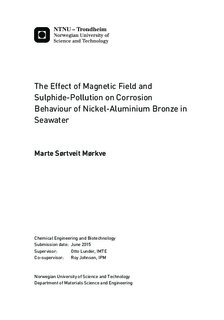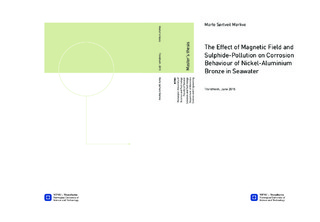| dc.description.abstract | The objective with this work was to investigate the corrosion behaviour of nickel-aluminium bronze in both pure and sulphide-polluted seawater, and possible synergy effects with an applied magnetic field (MF).
Two different test setups were used for electrochemical measurements in this work, i.e. with and without a MF. A MF in the range of 0,15-0,28 Tesla was applied. The corrosion testing included open circuit potentials (OCP) measurements, linear polarization resistance (LPR) and potentiodynamic polarization curves under a range of experimental conditions. pH measurements were performed to support the observations from OCP measurements. The sulphide-polluted test solution was made by adding Na2SxH20 to synthetic seawater (SSW). Sulphide contents of 1, 10 and 100 ppmW were investigated in this work. After ended test period, some samples were subjected to macroscopic and microscopic surface characterization by 3D light microscope, scanning electron microscope (SEM) and EDS analysis. X-ray diffraction was used for characterization of corrosion products. Long-term experiments were performed in the Sealab at Brattøra, while all other tests were done at the SINTEF and NTNU Corrosion Laboratory.
The results from OCP measurements revealed an increase in the potential to more positive values in the presence of sulphide. The MF had limited effect on OCP for fresh NAB in both pure SSW and sulphide-polluted SSW, while the OCP of long-term NAB shifted to more negative values in the presence of a MF. A protective oxide layer was developed on the surface of NAB after nine weeks of immersion in natural seawater, and the corrosion current density was found to be 1,5 mA/m2. The corrosion rate was found to be 33 times higher for fresh NAB compared to long-term NAB. Ahigher corrosion rate was calculated for fresh NAB in the presence of a MF. However, the limiting cathodic current density decreased when a MF was applied. The addition of sulphide to SSW accelerated the rate of charge transfer of oxygen reduction reaction. A. Several corrosion craters were also observed beneath the corrosion products after immersion in 10 ppmW sulphide-polluted SSW. | |

